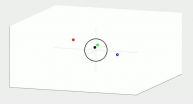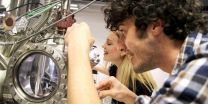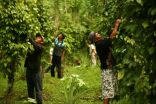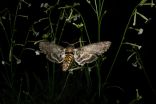(Press-News.org) Neuroscientists at Duke University have introduced a new paradigm for brain-machine interfaces that investigates the physiological properties and adaptability of brain circuits, and how the brains of two or more animals can work together to complete simple tasks.
These brain networks, or Brainets, are described in two articles to be published in the July 9, 2015, issue of Scientific Reports. In separate experiments reported in the journal, the brains of monkeys and the brains of rats are linked, allowing the animals to exchange sensory and motor information in real time to control movement or complete computations.
In one example, scientists linked the brains of rhesus macaque monkeys, who worked together to control the movements of the arm of a virtual avatar on a digital display in front of them. Each animal controlled two of three dimensions of movement for the same arm as they guided it together to touch a moving target.
In the rodent experiment, scientists networked the brains of four rats complete simple computational tasks involving pattern recognition, storage and retrieval of sensory information, and even weather forecasting.
Brain-machine interfaces (BMIs) are computational systems that allow subjects to use their brain signals to directly control the movements of artificial devices, such as robotic arms, exoskeletons or virtual avatars.
The Duke researchers, working at the Center for Neuroengineering, have previously built BMIs to capture and transmit the brain signals of individual rats, monkeys, and even human subjects to artificial devices.
"This is the first demonstration of a shared brain-machine interface, a paradigm that has been translated successfully over the past decades from studies in animals all the way to clinical applications," said Miguel Nicolelis, M.D., Ph. D., co-director of the Center for Neuroengineering at the Duke University School of Medicine and principal investigator for the study. "We foresee that shared BMIs will follow the same track, and could soon be translated to clinical practice."
To complete the experiments, Nicolelis and his team outfitted the animals with arrays implanted in their motor and somatosensory cortices to capture and transmit their brain activity.
For one experiment highlighted in the primate article, researchers recorded the electrical activity of more than 700 neurons from the brains of three monkeys as they moved a virtual arm toward a target. In this experiment, each monkey mentally controlled two out of three dimensions (i.e., x-axis and y-axis; see video) of the virtual arm.
The monkeys could be successful only when at least two of them synchronized their brains to produce continuous 3-D signals that moved the virtual arm. As the animals gained more experience and training in the motor task, researchers found that they adapted to the challenge.
The study described in the second paper used groups of three or four rats whose brains were interconnected via microwire arrays in the somatosensory cortex of the brain and received and transmitted information via those wires.
In one experiment, rats received temperature and barometric pressure information and were able to combine information with the other rats to predict an increased or decreased chance of rain. Under some conditions, the authors observed that the rat Brainet could perform at the same level or better than one rat on its own.
These results support the original claim of the same group that Brainets may serve as test beds for the development of organic computers created by the interfacing of multiple animal brains with computers.
Nicolelis and colleagues of the Walk Again Project, based in the project's laboratory in Brazil, are currently working on a non-invasive human Brainet to be used for neuro-rehabilitation training in paralyzed patients.
INFORMATION:
The human eye is an amazing instrument and can accurately distinguish between the tiniest, most subtle differences in color. Where human vision excels in one area, it seems to fall short in others, such as perceiving minuscule details because of the natural limitations of human optics.
In a paper published today in The Optical Society's new, high-impact journal Optica, a research team from the University of Stuttgart, Germany and the University of Eastern Finland, Joensuu, Finland, has harnessed the human eye's color-sensing strengths to give the eye the ability to ...
UBC research shows world's monitored seabird populations have dropped 70 per cent since the 1950s, a stark indication that marine ecosystems are not doing well.
Michelle Paleczny, a UBC master's student and researcher with the Sea Around Us project, and co-authors compiled information on more than 500 seabird populations from around the world, representing 19 per cent of the global seabird population. They found overall populations had declined by 69.6 per cent, equivalent to a loss of about 230 million birds in 60 years.
"Seabirds are particularly good indicators of ...
Chemotherapy treatment usually involves the patient receiving medicine through an intravenous catheter. These catheters, as well as the the equipment attached to them, are treated with a silver coating which is antibacterial, preventing bacterial growth and unwanted infections during a treatment.
Researchers at the Norwegian University of Science and Technology's (NTNU) Department of Physics are now studying what happens when different drugs come in contact with this silver coating.
Silver breaks down chemotherapy drugs
"We wanted to find potential problem sources ...
This news release is available in German.
Although global concentration of greenhouse gases in the atmosphere has continuously increased over the past decade, the mean global surface temperature has not followed the same path. A team of international reseachers, KIT scientists among them, have now found an explanation for this slowing down in global warming: the incoming solar radiation in the years 2008-2011 was twice as much reflected by volcanic aerosol particles in the lowest part of the stratosphere than previously thought. The team presents their study ...
In a recent article in Nature, Keith Shepherd and the Land Health Decisions team at the World Agroforestry Centre (ICRAF), together with their external partners, propose a radically new method to the SDG community that would answer these questions. They call on the United Nations and private sector to dispense with the highly criticized target setting approach and adopt the new method of decision analysis.
The target setting approach is widely seen as ineffective or counter-productive. Targeting emphasizes meeting a 'target' rather than learning how to improve performance ...
The quality of waters can be assessed using of the organisms occurring therein. This approach often results in errors, because many species look alike. Therefore, new methods focus on DNA analyses instead. Biologists at the Ruhr-Universität Bochum (RUB) have optimised the process so that they are now able to identify many organisms at once in a quick and reliable manner using short DNA sequences. The results have been published in the PLOS ONE magazine.
Expert knowledge for species identification threatens to disappear
Industry, agriculture and human settlement ...
Researchers at the University of Liverpool's Institute of Infection and Global Health (IGH) have discovered a common cause of heart damage in patients with sepsis.
Sepsis is the most common cause of death in hospitalised critically ill people and affects up to 18 million people world-wide annually.
The electrical and mechanical malfunctions of the heart have been poorly understood in sepsis, with underdeveloped clinical management strategies, as a consequence. This new discovery, however, promises to benefit a high number of patients with heart failure or rhythm ...
Since 1994, researchers at Case Western Reserve University have studied mothers--some who used cocaine while pregnant and others who did not--to understand how the drug affected their children's cognitive and social development.
Their latest findings suggest a link between prenatal cocaine exposure and an adolescent's likelihood to have sexual intercourse before age 15.
Teens who were prenatally cocaine exposed (PCE) were 2.2 times more likely to engage in sexual intercourse before age 15 than those who weren't, yet how PCE affects early sexual behavior may differ ...
This news release is available in German.
Some pollinators not only provide fertilization services for flowering plants, they also lay their eggs on the plants' leaves after they have visited the flowers. Voracious caterpillars hatch from these eggs and their enormous appetite can easily kill the plants. So when plants advertise for pollinators they frequently also attract herbivores. Scientists from the Max Planck Institute for Chemical Ecology in Jena, Germany, demonstrated in field trials that the flowers of the coyote tobacco Nicotiana attenuata are able ...
AMES, Iowa - Developing any habit--good or bad--starts with a routine, and exercise is no exception. The trick is making exercise a habit that is hard to break. According to a new Iowa State University study, that may be easier to accomplish by focusing on cues that make going for a run or to the gym automatic.
Some interventions designed to help people start and continue exercising may focus on the execution habit, or an exact routine to follow at the gym, said Alison Phillips, an assistant professor of psychology at Iowa State. However, Phillips' research, published ...






